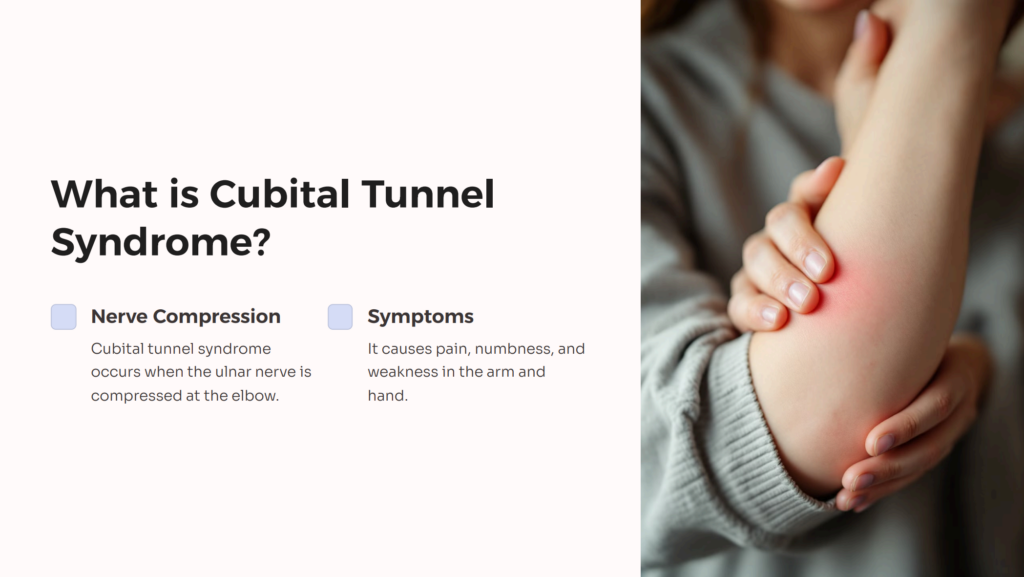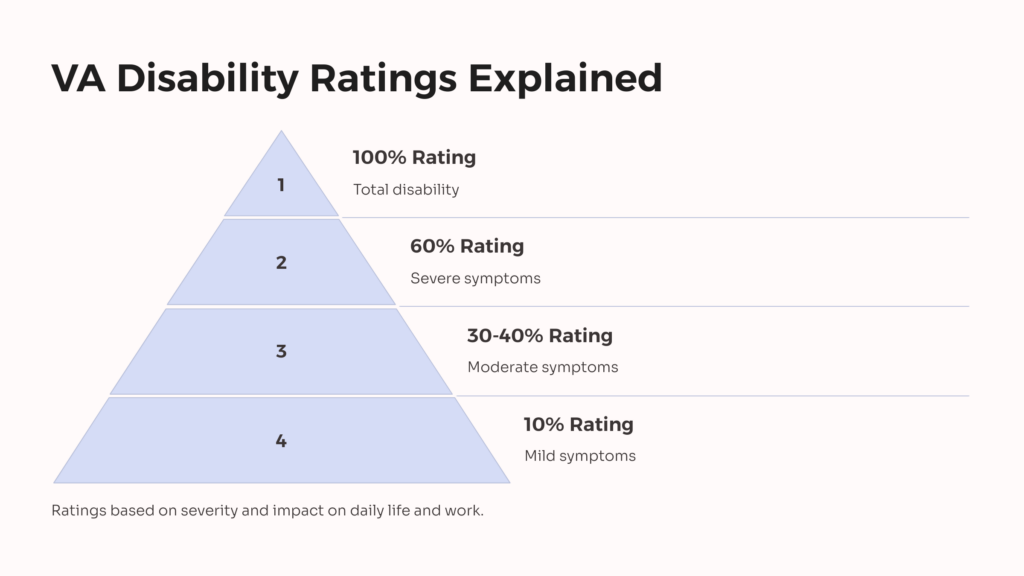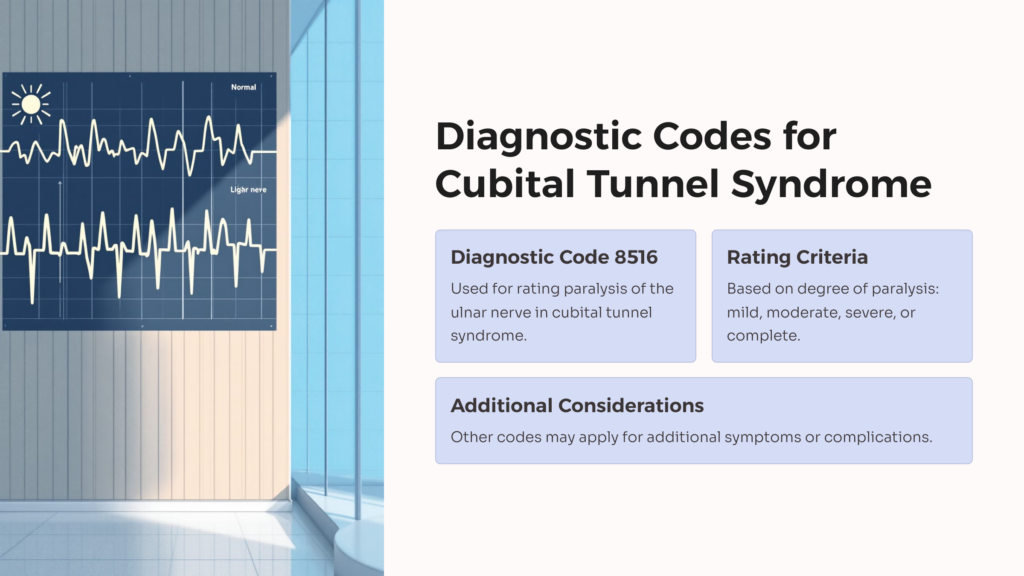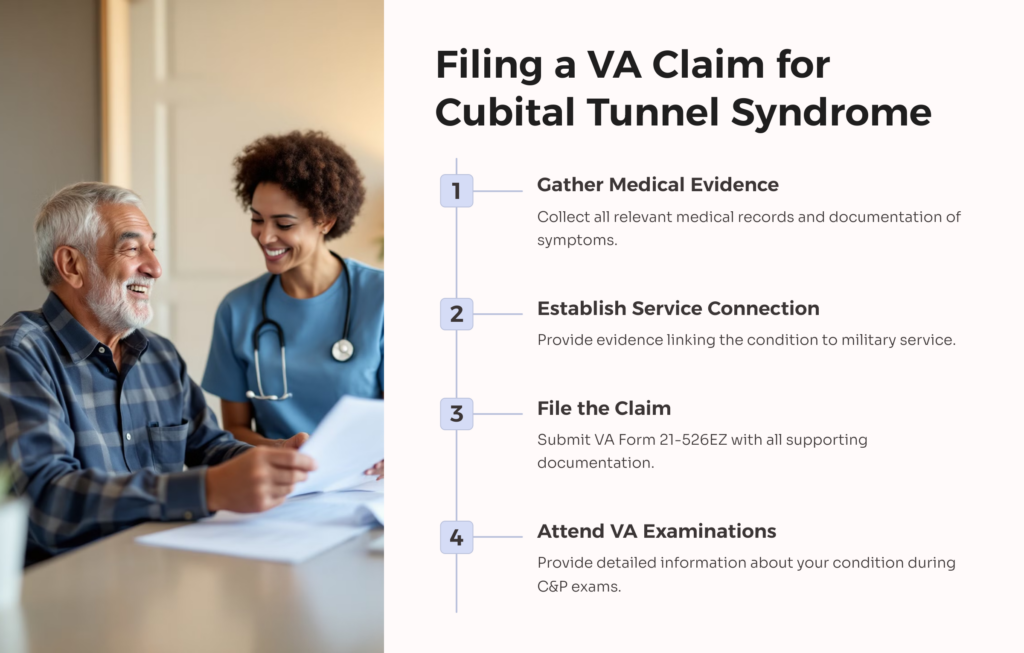
Cubital tunnel syndrome is a condition that affects the ulnar nerve, which runs along the inside of your elbow. This nerve is commonly known as the “funny bone” nerve. When it becomes compressed or irritated, it can cause pain, numbness, and weakness in the arm and hand.
The condition gets its name from the cubital tunnel, a narrow passageway on the inner part of the elbow. This tunnel is formed by bone, muscle, and ligaments. When the ulnar nerve becomes compressed as it passes through this tunnel, cubital tunnel syndrome develops.
Veterans may develop cubital tunnel syndrome due to repetitive motions, prolonged pressure on the elbow, or injuries sustained during military service. Activities like carrying heavy equipment, maintaining certain arm positions for extended periods, or experiencing direct trauma to the elbow area can all contribute to the development of this condition.
Difference Between Cubital Tunnel and Carpal Tunnel Syndromes
While cubital tunnel syndrome and carpal tunnel syndrome are both nerve compression disorders affecting the upper limbs, they involve different nerves and areas of the arm. Carpal tunnel syndrome affects the median nerve in the wrist, while cubital tunnel syndrome impacts the ulnar nerve at the elbow.
Carpal tunnel syndrome typically causes numbness, tingling, and pain in the thumb, index, middle, and part of the ring finger. It’s often associated with repetitive wrist movements or prolonged wrist flexion. On the other hand, cubital tunnel syndrome usually results in symptoms in the pinky and ring fingers, as well as the inner part of the hand and forearm.
Both conditions can affect veterans due to the physical demands of military service. However, it’s important to distinguish between the two when filing a VA claim, as they are rated differently and may require distinct treatment approaches.
Veterans can be service-connected for both conditions if they experience symptoms in multiple areas of the hand and arm. Proper diagnosis and documentation are crucial for ensuring accurate VA ratings and appropriate treatment.
VA Disability Ratings Explained

The Department of Veterans Affairs (VA) uses a rating system to determine the level of compensation for service-connected disabilities. These ratings are based on the severity of the condition and its impact on the veteran’s ability to function in daily life and work settings.
VA disability ratings are expressed in percentages, ranging from 0% to 100%. A 0% rating means the condition is present but doesn’t significantly impact the veteran’s ability to function, while a 100% rating indicates total disability. For cubital tunnel syndrome, ratings typically fall between 10% and 60%, depending on the severity of symptoms and which arm is affected.
It’s important to note that VA ratings are not just about the presence of a condition, but about how it affects the veteran’s life. The VA considers factors such as pain, limited motion, weakness, and the impact on employability when assigning ratings. For cubital tunnel syndrome, the VA will look at symptoms like numbness, tingling, pain, and loss of grip strength.
Veterans should be aware that ratings can change over time. If a condition worsens, veterans can file for an increased rating. Conversely, the VA may reduce a rating if there’s evidence of improvement. Regular medical evaluations and documentation of symptoms are crucial for maintaining an accurate disability rating.
Diagnostic Codes for Cubital Tunnel Syndrome

When rating cubital tunnel syndrome, the VA typically uses Diagnostic Code 8516, which pertains to paralysis of the ulnar nerve. This code provides ratings based on the degree of paralysis or impairment of the nerve.
Under Diagnostic Code 8516, the ratings are as follows:
- 10% for mild incomplete paralysis
- 20% (minor arm) or 30% (major arm) for moderate incomplete paralysis
- 30% (minor arm) or 40% (major arm) for severe incomplete paralysis
- 50% (minor arm) or 60% (major arm) for complete paralysis
Complete paralysis is characterized by symptoms such as the “griffin claw” deformity, significant atrophy of certain muscles, and inability to spread or adduct the fingers. However, most cases of cubital tunnel syndrome fall under the incomplete paralysis categories.
It’s worth noting that the VA may also consider other diagnostic codes if there are additional symptoms or complications. For example, if there’s significant limitation of motion in the elbow, Diagnostic Code 5206 (limitation of flexion of the forearm) might be considered.
Veterans should ensure that their medical records clearly describe their symptoms and functional limitations to help the VA accurately apply the appropriate diagnostic code and rating.
Understanding the Bilateral Factor
For veterans experiencing cubital tunnel syndrome in both arms, the VA applies a concept known as the bilateral factor. This factor recognizes that having a disability affecting both sides of the body creates a greater overall impairment than the sum of the individual ratings.
The bilateral factor is calculated by taking 10% of the combined rating for the bilateral disabilities and adding it to the combined rating. For example, if a veteran has a 20% rating for cubital tunnel syndrome in each arm, the combined rating would be 36%. The bilateral factor would add an additional 3.6% (10% of 36%), resulting in a final combined rating of 40%.
Understanding the bilateral factor is important for veterans with cubital tunnel syndrome affecting both arms. It can result in a higher overall disability rating, which in turn can lead to increased compensation. Veterans should ensure that symptoms in both arms are thoroughly documented and reported during VA examinations.
The application of the bilateral factor is automatic when the conditions qualify. However, veterans and their representatives should review rating decisions to ensure it has been correctly applied when appropriate.
Impact of Cubital Tunnel Syndrome on Sleep and Mental Health
Cubital tunnel syndrome can have far-reaching effects beyond just arm and hand discomfort. Many veterans with this condition report significant sleep disturbances, which can in turn impact their mental health and overall quality of life.
The pain and numbness associated with cubital tunnel syndrome often worsen at night, particularly when the elbow is bent during sleep. This can lead to frequent awakening, difficulty falling asleep, and poor sleep quality. Chronic sleep deprivation can contribute to mood disorders, cognitive difficulties, and decreased daytime functioning.
Furthermore, the persistent pain and functional limitations caused by cubital tunnel syndrome can lead to frustration, anxiety, and depression. Veterans may find themselves unable to perform tasks they once did with ease, leading to feelings of helplessness or loss of identity.
It’s important for veterans experiencing these secondary effects to discuss them with their healthcare providers and include this information in their VA claims. The VA recognizes that conditions like cubital tunnel syndrome can have mental health implications, and these factors may be considered in the overall disability rating or potentially lead to secondary service connection for mental health conditions.
Total Disability Individual Unemployability (TDIU) and Cubital Tunnel Syndrome
For some veterans, cubital tunnel syndrome may be severe enough to prevent them from maintaining substantially gainful employment. In such cases, they may be eligible for Total Disability Individual Unemployability (TDIU) benefits.
TDIU allows veterans to receive compensation at the 100% rate, even if their combined disability rating is less than 100%. To qualify for TDIU, veterans must have:
1. At least one service-connected disability rated at 60% or more, OR
2. Two or more service-connected disabilities with at least one rated at 40% or more, and a combined rating of 70% or more.
Additionally, the veteran must be unable to maintain substantially gainful employment due to their service-connected disabilities. For cubital tunnel syndrome, this might mean being unable to perform tasks requiring manual dexterity, grip strength, or prolonged use of the arms.
Veterans applying for TDIU should provide detailed information about how their cubital tunnel syndrome affects their ability to work. This can include statements from employers, coworkers, or vocational experts. Medical evidence demonstrating the severity of the condition and its impact on occupational functioning is also crucial.
It’s important to note that TDIU is not automatically considered by the VA. Veterans who believe they may qualify should explicitly file for TDIU using VA Form 21-8940.
Filing a VA Claim for Cubital Tunnel Syndrome

Filing a successful VA claim for cubital tunnel syndrome requires careful preparation and documentation. Here are some key steps veterans should follow:
1. Gather medical evidence: Collect all relevant medical records, including diagnoses, treatment plans, and documentation of symptoms. Include both military and civilian medical records.
2. Establish service connection: Provide evidence linking your cubital tunnel syndrome to your military service. This could include service treatment records, statements from fellow service members, or medical opinions connecting your condition to in-service activities or injuries.
3. Document current symptoms: Keep a detailed log of your symptoms, including frequency, severity, and impact on daily activities. This can help demonstrate the current level of disability.
4. Get a medical opinion: If possible, obtain a written opinion from your treating physician about the severity of your condition and its connection to your military service.
5. File the claim: Submit your claim using VA Form 21-526EZ, along with all supporting documentation. You can file online through the VA’s eBenefits portal, by mail, or in person at a VA regional office.
6. Attend VA examinations: The VA may schedule you for a Compensation and Pension (C&P) exam. Attend this exam and provide honest, detailed information about your condition.
Remember, the key to a successful claim is providing comprehensive, well-documented evidence of your condition and its impact on your life. Don’t hesitate to seek assistance from a Veterans Service Organization or a VA-accredited attorney if you need help with your claim.
Appealing a VA Disability Rating Decision
If you disagree with the VA’s decision on your cubital tunnel syndrome claim, you have the right to appeal. The appeals process can be complex, but understanding your options is crucial for potentially obtaining a higher rating.
Under the current Appeals Modernization Act (AMA) system, veterans have three options for appealing a decision:
1. Higher-Level Review: You can request a senior VA employee to review your case. No new evidence can be submitted with this option.
2. Supplemental Claim: This allows you to submit new and relevant evidence to support your claim.
3. Appeal to the Board of Veterans’ Appeals: You can appeal directly to the Board, with options for submitting new evidence or requesting a hearing.
When appealing a cubital tunnel syndrome rating, consider the following:
- Review the rating decision carefully to understand why the VA assigned the rating they did.
- Gather any new medical evidence that supports a higher rating, such as worsened symptoms or additional functional limitations.
- Consider obtaining a private medical opinion that addresses the rating criteria specifically.
- Be prepared to explain how your symptoms align with the criteria for a higher rating under Diagnostic Code 8516.
Remember, the appeal process can be time-consuming, but it’s often worthwhile if you believe you’re entitled to a higher rating. Don’t be discouraged if your initial claim is denied or rated lower than expected – many veterans succeed in obtaining higher ratings through the appeals process.
How VA-Accredited Attorneys Can Assist
Navigating the VA claims process for cubital tunnel syndrome can be challenging. VA-accredited attorneys can provide valuable assistance throughout the process, from initial claim filing to appeals.
These attorneys specialize in veterans’ law and understand the intricacies of the VA system. They can help in several ways:
1. Case evaluation: They can review your case to determine the strength of your claim and identify any areas that need additional evidence or documentation.
2. Evidence gathering: Attorneys can help collect necessary medical records, service records, and other documentation to support your claim.
3. Claim preparation: They can assist in preparing your claim to ensure all required information is included and presented effectively.
4. Appeals assistance: If your claim is denied or you receive a lower rating than expected, an attorney can guide you through the appeals process, helping to build a strong case for a higher rating.
5. Representation at hearings: If your appeal goes to a hearing, an attorney can represent you, presenting arguments and evidence on your behalf.
6. Understanding of VA law: Attorneys stay up-to-date with changes in VA regulations and case law, ensuring your claim is handled according to the most current standards.
While veterans are not required to use an attorney for VA claims, many find that professional legal assistance significantly improves their chances of a favorable outcome, especially in complex cases or appeals.
It’s important to note that VA-accredited attorneys can only charge fees for services related to appeals, not for initial claim filing. Many offer free initial consultations to evaluate your case
Frequently Asked Questions About VA Ratings for Cubital Tunnel Syndrome
1. Can I receive VA disability compensation for cubital tunnel syndrome? Yes, if you can establish that your cubital tunnel syndrome is related to your military service and it causes functional impairment.
2. How does the VA determine the rating for cubital tunnel syndrome? The VA uses Diagnostic Code 8516, which rates the condition based on the severity of incomplete or complete paralysis of the ulnar nerve.
3. Can I receive separate ratings for cubital tunnel syndrome in both arms? Yes, you can receive separate ratings for each arm affected. The bilateral factor will also be applied to increase your overall combined rating.
4. Will my cubital tunnel syndrome rating be permanent? Not necessarily. The VA may schedule future examinations to reassess the severity of your condition. Ratings can be increased or decreased based on these reevaluations.
5. Can cubital tunnel syndrome qualify me for Total Disability Individual Unemployability (TDIU)? Potentially, if your cubital tunnel syndrome is severe enough to prevent you from maintaining substantially gainful employment and you meet the rating criteria for TDIU.
Remember, every veteran’s situation is unique. If you have specific questions about your claim or rating, it’s best to consult with a VA representative or accredited attorney for personalized advice.
 AllVeteran.com Advisors
AllVeteran.com Advisors
With expertise spanning local, state, and federal benefit programs, our team is dedicated to guiding individuals towards the perfect program tailored to their unique circumstances.











